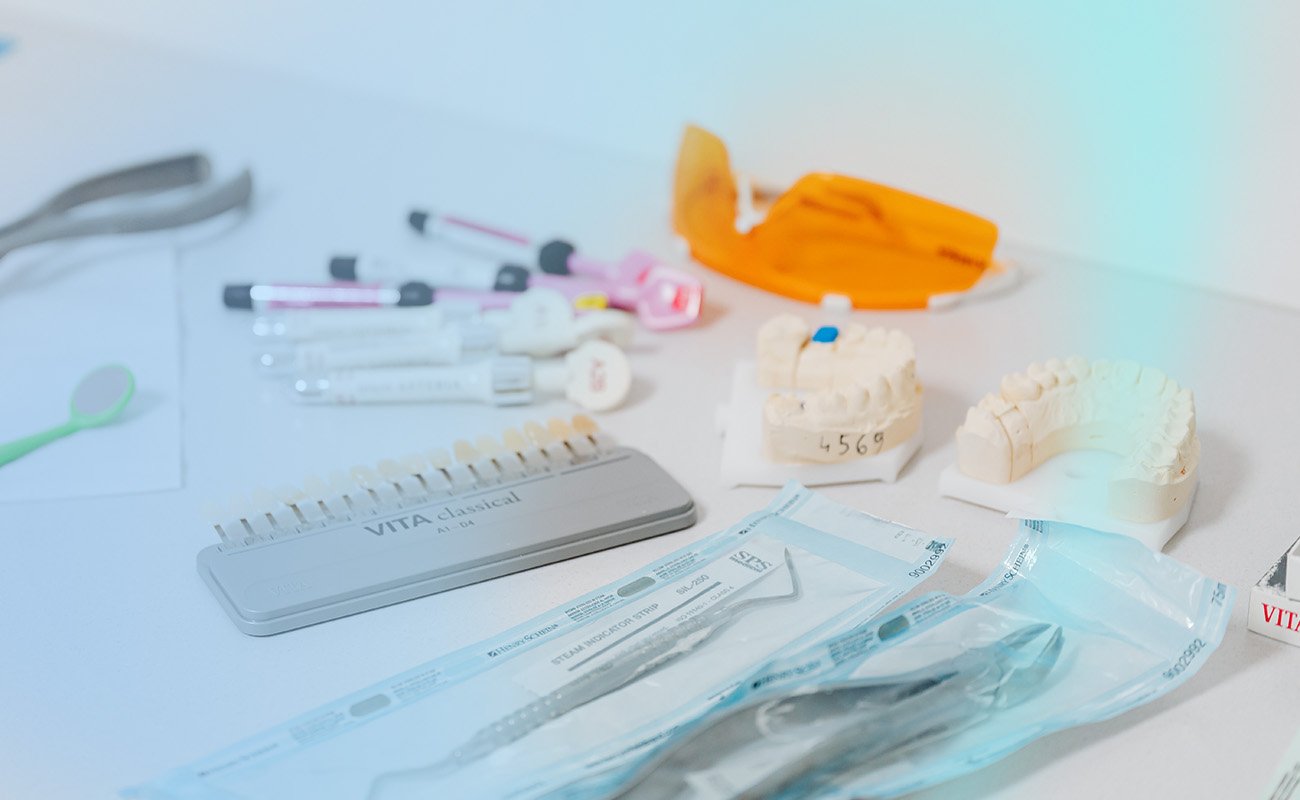Feeling uneasy about your misaligned or spaced teeth but not keen on the idea of traditional braces or clear aligners? There’s good news: several discreet methods are available for straightening your smile without the conspicuousness and inconvenience of standard orthodontic treatments. Options range from dental bonding to lingual appliances, offering minimally invasive solutions for improving teeth alignment and bite issues.
In this guide, we’ll explore some of the top “braces-free” approaches for adjusting tooth positioning and achieving a more uniform smile shape. If a low-key and cost-effective smile enhancement is what you’re after, continue reading to uncover the ideal solution for achieving a straighter, more harmonious smile without the need for overt orthodontics.
Veneers
Dental veneers are a cosmetic option for achieving a straighter smile without traditional braces. These thin, custom shells cover the front surface of teeth, correcting minor misalignments, gaps, and shape issues. Made from porcelain or composite resin, veneers are durable and offer a natural look.
The application process involves removing a small amount of tooth enamel to fit the veneer, making it irreversible. Costs for veneers vary, ranging from $250 to $2,500 per tooth, depending on the material and the complexity of the dental work required.
Despite their ability to transform a smile with immediate effect and their resistance to discoloration, veneers are not a one-size-fits-all solution. They are less effective for significant orthodontic adjustments and do not address the root causes of dental misalignment. Advantages include the rapid improvement in the appearance of teeth and their stain-resistant nature, but drawbacks encompass the significant cost, the possibility of replacement over time, and the irreversible nature of the enamel removal process.
See our article: Are Veneers Permanent? Facts and Myths about Veneers
Worth Knowing
The study published in the Journal of Dental Research shows that patient factors, rather than dentist-related factors, significantly influence the longevity of porcelain veneers. It was found that 53% of these veneers remained intact and did not require any re-intervention for up to 10 years.
Dental Bonding
Dental bonding is a non-invasive cosmetic procedure that can be used to make minor corrections to the alignment of teeth without the need for braces. In this process, a tooth-colored resin material is applied directly to the teeth and then shaped and hardened using a special light. This method allows dentists to adjust the appearance of teeth, filling in gaps and correcting minor crookedness with precision.
The resin used in dental bonding is made from a durable plastic material that blends seamlessly with the natural color of teeth. The cost of dental bonding is relatively affordable, typically ranging from $300 to $600 per tooth, making it an economical option for cosmetic dental improvements.
One of the major advantages of dental bonding is its simplicity and the minimal tooth preparation required, preserving more of the natural tooth structure. However, the material used in bonding is not as strong as natural teeth or other dental restorations like veneers or crowns, making it more susceptible to chips and stains over time. Additionally, while dental bonding can provide immediate improvements, it may not be suitable for more severe alignment issues that require orthodontic intervention.
Worth Knowing
Research featured in Clinical Oral Investigations reveals that four years post-procedure, 92.8% of dental bonding treatments remain in excellent condition. The study assessed various aspects such as color match, fit at the edges, surface texture, edge discoloration, wear, shape retention, and cavity prevention, all of which maintained high standards after four years of clinical observation.
Lingual Braces
Lingual braces offer a discreet way to straighten teeth, functioning similarly to traditional braces but with a twist: they are attached to the back side of the teeth, making them invisible from the front. Made from the same materials as conventional braces, such as metal brackets and wires, lingual braces apply continuous pressure to teeth, gradually shifting them into the desired position.
The cost of lingual braces tends to be higher than traditional braces due to their customized design and the specialized technique required for their placement, with prices often ranging from $8,000 to $10,000.
One of the main advantages of lingual braces is their invisibility. However, they can be more challenging to clean due to their placement and may cause discomfort to the tongue, especially during the initial adjustment period. Additionally, lingual braces might not be suitable for all types of orthodontic cases, particularly those requiring significant tooth movement.
Retainers
Retainers are a common orthodontic device used either post-braces to maintain tooth position or, in some mild cases, as a standalone option to correct minor misalignments. They work by holding the teeth in place, preventing them from shifting back to their original positions.
Retainers can be made from a combination of materials, including clear plastic for removable types, like the Hawley or Essix retainers, or metal wires for fixed versions. The cost of retainers varies, generally ranging from $100 to $500, depending on the type and customization required.
One of the benefits of retainers is their subtlety and removability. However, their effectiveness is limited to minor corrections and maintaining alignment post-orthodontic treatment. Additionally, they must be worn consistently as directed by a dental professional to prevent teeth from shifting back to their original position, and improper care can lead to damage or the need for replacement.
See our article: Can You Get Retainers Without Braces?
Clear Aligners
Another alternative to in-office orthodontic treatment are the direct-to-consumer clear aligner companies that have emerged in recent years. Brands like Candid and Byte allow customers to receive clear plastic aligner treatment remotely. The process typically begins by taking teeth impressions or intraoral scans at home and sending them to the company. They then manufacture a series of custom aligners made of clear thermoplastic material that are mailed directly to the customer, along with instructions for swapping each new aligner tray in sequentially every couple of weeks to gradually shift the teeth into alignment.
At-home aligner treatment generally costs $1,000-$2,500, which is lower than in-office clear aligner therapy from an orthodontist. The clear plastic aligners are also removable and nearly invisible. However, treatment is usually limited to more simple tooth alignment cases without significant bite issues. There is also less frequent oversight and monitoring compared to in-office visits with an orthodontist.
See our article: Braces by Mail.
See our reviews of the best invisible aligners
AlignerCo is a well-known brand that provides an affordable aligner program. Their prices are lower than most other aligner brands, with treatment starting at just $945, which also includes free retainers and a teeth whitening kit.

AlignerCo
The cheapest at-home aligners, with monthly plans, no down payment, and considerable discounts.
Check out AlignerCo AlignersNewSmile is one of the newest aligner brands on the market and is known for its affordability. When you purchase their aligners, you receive an impression kit, whitening foam, aligners, and retainers. This brand also provides monthly payment plans without requiring any initial payments, offers a video call option with a specialist to assist with mouth impressions, and has a user-friendly online assessment process.

NewSmile
Affordable at-home treatment with positive reviews offering superior look and comfort.
Check out NewSmile AlignersByte is a well-known brand that offers a lifetime guarantee for your aligners. This means that if your teeth don’t stay in the desired treatment position afterward, you’ll receive additional impression kits, treatment plans, and sets of aligners at no additional cost to correct any misalignments.

Byte
An affordable option with refundable impression kits, free HyperByte, and a Byte for Life guarantee.
Check out Byte AlignersCandid is a highly regarded aligner product with a treatment approach similar to Invisalign. Unlike the other brands mentioned, Candid doesn’t offer a direct-to-home ordering service. Instead, a qualified orthodontist will assess your eligibility for treatment. The advantage is that you won’t need regular appointments after starting treatment. Candid aligners are suitable for addressing both mild and severe spacing issues.

Candid
A hybrid of in-office and at-home treatment that provides 1-on-1 orthodontist support.
Check out Candid AlignersCan I Straighten My Teeth by Myself?
It is not recommended to straighten your teeth by yourself. An article on the WebMD website by Health Day Reporter Mary Elizabeth Dallas referring to feedback from the AAO recalls instances where some people have resorted to using potentially dangerous items such as string, rubber bands, paper clips, and even fake retainers to avoid orthodontist treatment to straighten their teeth.
While seeking to straighten teeth on your own may seem appealing to avoid orthodontist costs, attempting DIY teeth alignment is extremely inadvisable and risky. Trying to shift teeth haphazardly without professional oversight can lead to significant issues like uneven spacing, painful jaw misalignment, tooth loss or nerve damage.
There is however one solution that allows you to straighten your teeth without the need for orthodontic appointments, clear aligners. There are several aligner brands including Byte that, unlike Invisalign, allow you to begin and complete treatment yourself from the comfort of your own home.
These aligners are custom-fitted at home and offer a great opportunity for those who might not have access to or afford regular visits to an orthodontist. The aligners work by gradually shifting their position and realigning crooked teeth over time into better positions.
Frequently Asked Questions
How Can I Straighten My Teeth Without Braces?
There are several alternatives to braces when considering teeth straightening treatment. These include veneers, dental bonding, crowns, or clear aligners.
Some types of teeth straightening solutions, such as clear aligners, allow you to undertake treatment without any orthodontic visits too.
What is the Fastest Way to Straighten Teeth?
Clear aligners are the quickest way to straighten teeth with a treatment time of 6 months in some cases. Aligners offer an affordable and efficient solution to teeth straightening and are ideal for patients with mild to mid malocclusions.
Sources
Alothman, Y., Bamasoud, M. S., The Success of Dental Veneers According To Preparation Design and Material Type, Open Access Maced J Med Sci. 2018 Dec 20; DOI: 10.3889/oamjms.2018.353. Available online at: https://www.ncbi.nlm.nih.gov/pmc/articles/PMC6311473/
Matos, A. B., Tosi Trevelin, L., Ferreira da Silva, B. T., Fávaro Francisconi-Dos-Rios, L., Kfouri Siriani, L., Cardoso, M. V., Bonding efficiency and durability: current possibilities. Braz Oral Res. 2017 Aug 28;31(suppl 1):e57. doi: 10.1590/1807-3107BOR-2017.vol31.0057. Available online at: https://pubmed.ncbi.nlm.nih.gov/28902237/
Tamer, I. et al. Orthodontic Treatment with Clear Aligners and The Scientific Reality Behind Their Marketing: A Literature Review. Turkish Journal of Orthodontics. 2019. doi: 10.5152/TurkJOrthod.2019.18083. Available online at: https://www.ncbi.nlm.nih.gov/pmc/articles/PMC7018497/

